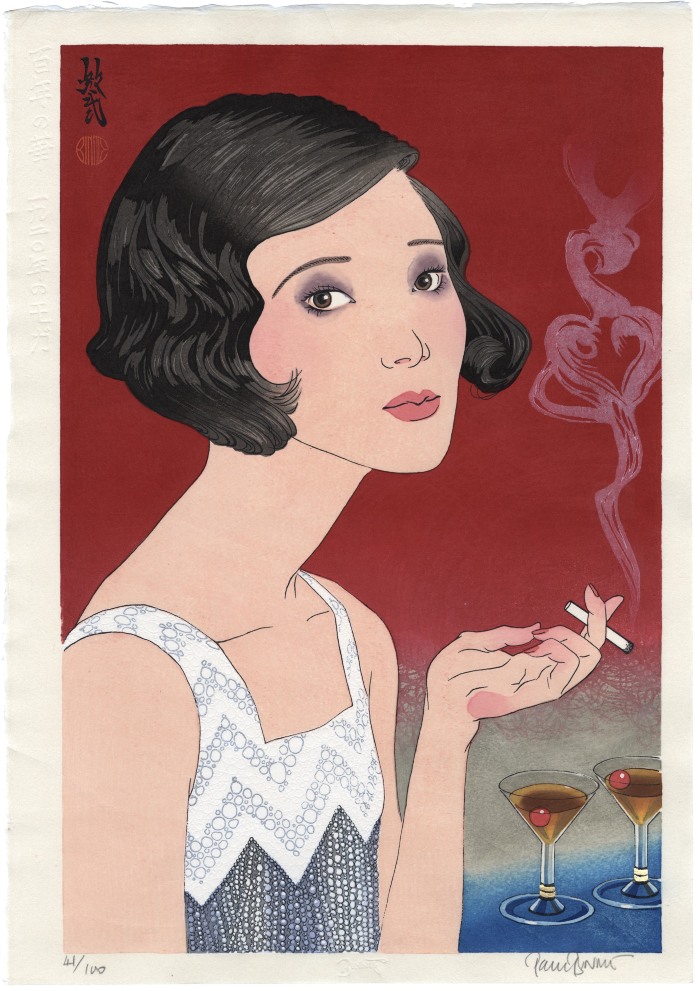Paul Binnie (artist 1967 –)
Moga - A Modern Girl of 1920 (Ichikyū-nirei-nen no moga: 一九二0年モガ)
2012 – 2013
13.25 in x 18.5 in (Overall dimensions) Japanese woodblock print
Hyakunen no Hana & print title Senkyuhakunijuunen no Moga in blind-printing on upper left margin & Binnie on the bottom margin, signed in kanji, Bin-ni at upper left followed by red artist's seal Binnie, numbered and signed in pencil 41/100
The Binnie Catalogue Moga - a Modern Girl (of 1920), the third design from Binnie's series Hyakunen no Hana (百年の華) - Flowers of a Hundred Years.
At the binniecatalog.com it says of this print:
"The Japanese title Moga, is a contraction of the first two syllables of the two words of the phrase; i.e. modan (modern) and garu (girl). Moga were a cultural phenomenon similar to flappers in the West, young women who escaped from the paternalism and family controls of previous decades and did many things the older generations found shocking. They cut their hair into shorter styles, wore western-style clothes, smoked cigarettes and drank alcohol - such as the Manhattan cocktails we see here - while dancing or flirting with young men (hence two cocktails), things we might take for granted today, but which were a complete break with expectations of more traditional Japanese society. The 1920s were an economic boom period, and young women could have jobs that gave them freedom to live their lives away from controls and restrictions imposed by their parents’ generation. A flood of images and ideas from the West entered Japan between the wars, and the colour scheme of this design reflects the red, white and blue of the USA, Britain and France, all countries Moga were fascinated by."
"There is a famous and rare print by the Shin Hanga (New Prints) artist Kobayakawa Kiyoshi called Horoyoi (Tipsy) of 1930, and this was a reference point for Moga, particularly in the strong deep-red background. However, Kiyoshi seems to criticise his slightly drunk, chubby and bleary-eyed model, whereas Paul Binnie's feeling about the new freedoms of the period is one of wholehearted support, and he celebrates the new-found independence women were taking for themselves at this time."
"The new print is in the same format as the first two designs in the set, Kuchi-e and Ebicha Hakama, a large dai-ōban format. As before in this set, the printing is lavish, and as well as 47 colour and bokashi (shading) printings, it employs mica, embossing, silver metallic pigment and 23-carat gold leaf."
****
Binnie carved and printed this piece himself.
****
Scholten Japanese Art added in their description of this print: "This beauty displays all of the accoutrements of a typical moga: bobbed hair, flashy Western clothing (the richness of her dress is emphasized with blind-printing and highlighted with mica) revealing a shocking amount of skin, and make-up with sultry, smoky eyes. Unlike a chaste and appropriate young woman of an earlier time, this beauty confidently holds our gaze while elegantly brandishing a lit cigarette. Just off to the side are two cocktails (with gold bands on the glasses), the amber color and Maraschino cherry garnish suggest they are Manhattan cocktails, which was one of the more popular concoctions of the Jazz Age. Of course the presence of two drinks indicates she is not alone."
self-printed (sōsaku hanga - 創作版画) (genre)
beautiful woman picture (bijin-ga - 美人画) (genre)
